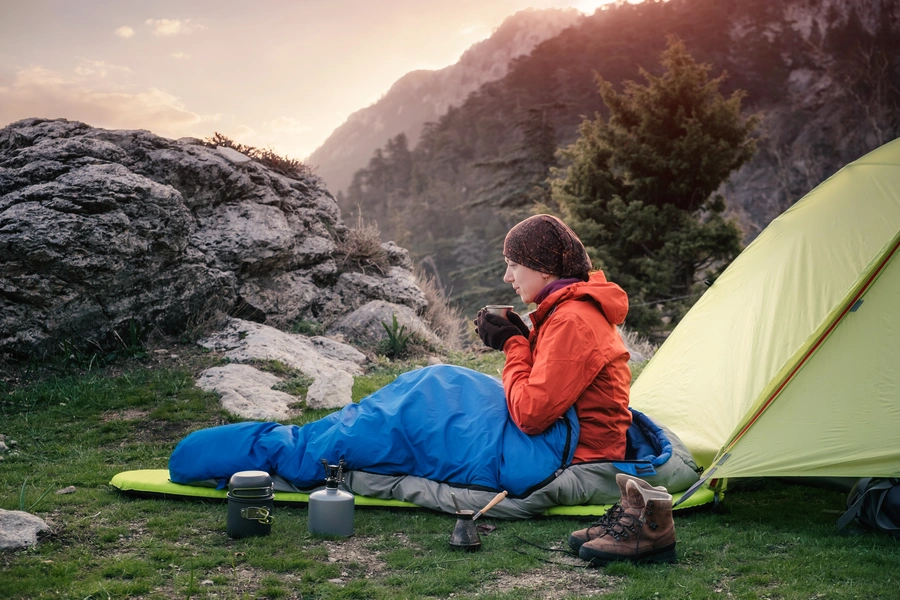When you’re packing for a camping trip, a sleeping bag is a must-have on your checklist. With the right sleeping bag tailored to your needs, you can ensure comfort and warmth throughout your outdoor adventures. Whether you’re new to camping or just brushing up on your gear knowledge, this guide will help you navigate through the choices to find the perfect sleeping bag.
Understanding Sleeping Bag Shapes and Sizes
Sleeping bags come in various shapes and sizes, each designed for specific needs and preferences:
1. Mummy Bag Shape: Ideal for backpackers, the mummy bag is designed to fit snugly, with a tapered shape that follows the contour of your body. It excels in heat retention and minimises pack size, making it perfect for carrying in a rucksack. However, if you like to move around in your sleep, you might find it restrictive.
2. Rectangular Bag Shape: Offering a bed-like feel, rectangular sleeping bags are spacious and comfortable with zippers on both sides. They can fully unzip to double as a duvet and can be zipped together with another bag to make a double bed. This design is less warm than the mummy shape but perfect for car camping or indoor use.
3. Double Bag Shape: This option is essentially a wider version of the rectangular bag, suitable for couples or those who prefer more space. It’s bulky but can be a practical choice if you want to carry less by combining two sleeping spaces into one.
4. Women’s Specific Bag: Designed with women’s physiology in mind, these bags feature extra insulation in key areas and are generally shorter and narrower to enhance warmth and reduce bulk.
Choosing the Right Insulation
Synthetic Insulation: Synthetic bags are recognised for their cost-effectiveness and resilience, retaining insulation even when wet. They are ideal for wet conditions and festival settings where spills and dirt are frequent. While synthetic bags may be heavier and bulkier than down bags, they are durable and typically need less upkeep.
Down Insulation: Down insulation is unmatched in providing lightweight warmth, making it ideal for cold environments where weight and space are essential. However, it is important to handle down carefully as it loses its insulating properties when wet. Choosing high-fill power down ensures superior warmth, making it a great option for tough alpine conditions.
Navigating Warmth Ratings
Sleeping bags are rated by season to help you choose based on the typical temperatures you’ll encounter:
- One Season: Suitable for summer camping in warm climates.
- Two Season: Good for late spring through early autumn.
- Three Season: Versatile for spring through fall, capable of handling slightly below-freezing temperatures.
- Four Season: Designed for winter weather, providing warmth in low temperatures.
- Four+ Season: Intended for extreme conditions like high altitudes or arctic cold.
Comfort ratings are also important:
- Comfort Temperature: Indicates the lowest temp at which the average woman can sleep comfortably.
- Limit Temperature: Shows the lowest temp at which the average man can sleep comfortably.
- Extreme Temperature: Represents a survival-only rating for women and should not be relied upon for comfort.
Key Features to Consider
- Shoulder Baffles: Help trap heat in and keep cold out.
- Zippers: Full-length zippers offer flexibility; consider the side that best suits your dominant hand.
- Compression Sacks: Allow you to compress the sleeping bag for easy packing.
- Hoods: Essential for mummy bags, they help retain head warmth.
- Inner Pockets: Useful for keeping small items like phones warm and safe.
- Outer Shell and Inner Lining Materials: Choose materials based on the specific activities you plan to engage in.
Aftercare Tips
It is important to properly maintain your sleeping bag in order to extend its lifespan and ensure it remains effective. Avoid washing it excessively and use appropriate cleaning products when necessary. Store your sleeping bag in a loose, spacious bag to maintain its loftiness instead of compressing it.
When selecting the right sleeping bag, it is important to take into account the unique camping conditions, individual comfort preferences, and the practical attributes that will improve your outdoor adventure.

